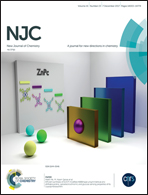Enhancing the power conversion efficiency of polymer solar cells via selection of quinoxaline substituents†
Abstract
In this study, three random copolymers including quinoxaline derivatives with different substituent groups, 2,6-bis(trimethylstannyl)-4,8-bis(2-ethylhexyloxy)benzo[1,2-b:4,5-b′]dithiophene and 4,7-dibromo-2-(2-octyldodecyl)-2H-benzo[d][1,2,3]triazole, were designed and synthesized according to the donor–acceptor (D–A) approach. 1H NMR spectroscopy, UV-Vis absorption spectroscopy, cyclic voltammetry, and gel permeation chromatography were utilized for the characterization of the polymers. Optical studies were performed in order to investigate the absorption behaviors of the polymers. P1, P2 and P3 demonstrate broad visible light absorption behavior with maximum absorption peaks around 374/539, 493/535 and 488/532 nm and their optical band gap values were calculated as 1.74, 1.87 and 1.70 eV respectively. Bulk heterojunction photovoltaic devices were fabricated using the synthesized polymers as electron donors with fullerene derivatives where the best power conversion efficiencies were found to be 2.03% for P1 : PC71BM (1 : 3, w : w), 2.22% for P2 : PC71BM (1 : 4, w : w) and 1.52% for P3 : PC71BM (1 : 2, w : w) with methanol treatment.



 Please wait while we load your content...
Please wait while we load your content...